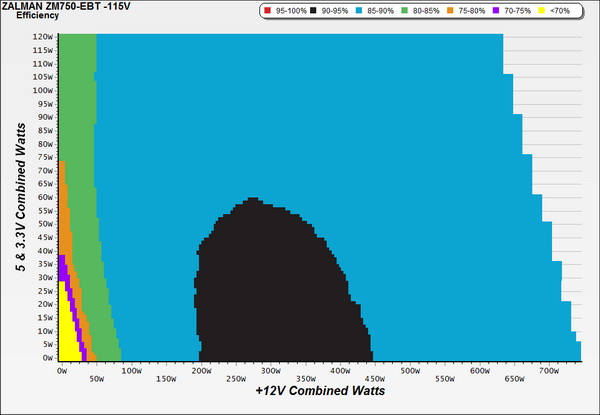Zalman ZM750-EBT PSU Review
Zalman's new EBT line consists of four PSUs ranging from 650W to 1kW capacity. Today, we're testing the ZM750-EBT, which, thanks to a low price, achieves a good value score. But how does it fare in terms of absolute performance?
Why you can trust Tom's Hardware
Cross-Load Tests And Infrared Images
Our cross-load tests are described in detail here.
To generate the following charts, we set our loaders to auto mode through our custom-made software before trying more than 1500 possible load combinations with the +12V, 5V and 3.3V rails. The load regulation deviations in each of the charts below were calculated by taking the nominal values of the rails (12V, 5V and 3.3V) as point zero.
Load Regulation Charts
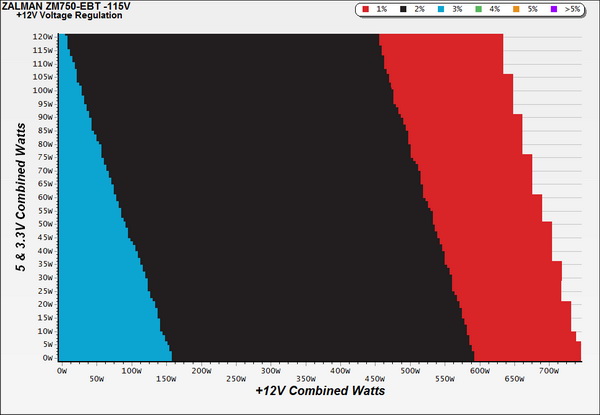

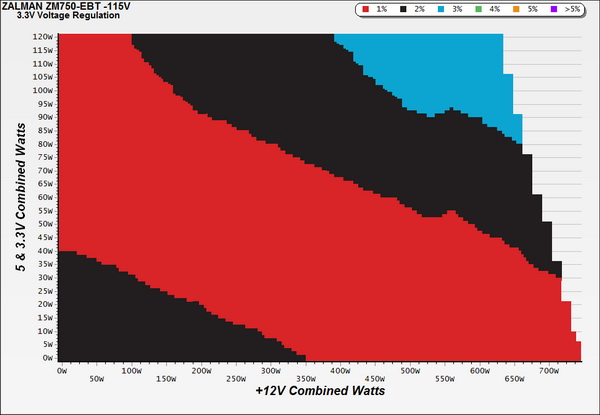
Efficiency Chart
For a Gold-rated platform featuring an LLC resonant converter, and considering the small bulk cap, we expected much higher efficiency. Obviously, Zalman (actually Sirfa) focused more on cutting production cost than offering the best possible performance.
Ripple Charts

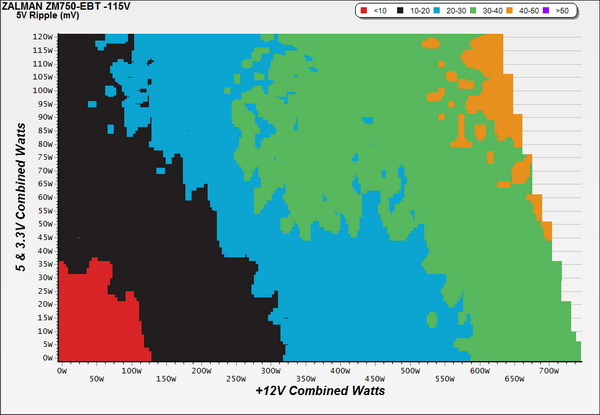
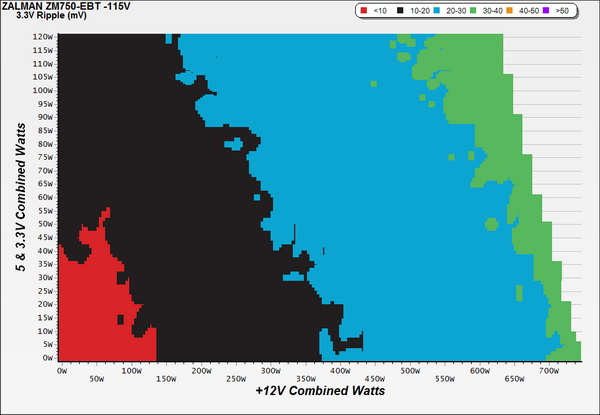

Infrared Images
Toward the end of the cross-load tests, we took some photos of the PSU with our modified FLIR E4 camera that delivers 320x240 IR resolution (76,800 pixels).
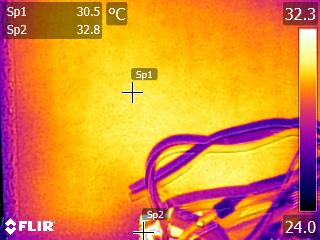
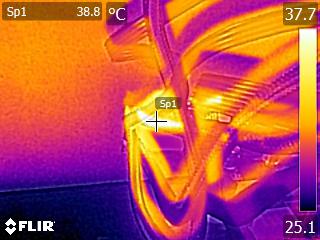
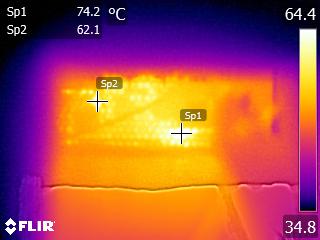

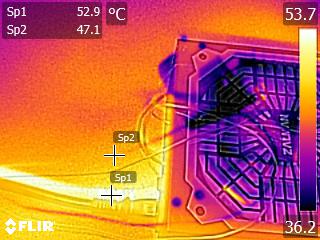
Although the aggressive fan profile is bad for acoustic performance, it enables low internal temperatures, even during our worst-case testing. This will prove beneficial to the PSU's longevity.
Get Tom's Hardware's best news and in-depth reviews, straight to your inbox.
Current page: Cross-Load Tests And Infrared Images
Prev Page Efficiency, Temperature And Noise Next Page Transient Response Tests
Aris Mpitziopoulos is a contributing editor at Tom's Hardware, covering PSUs.
-
Onus Although the article does mention safety, a very valid point, it still managed to imply that a single-rail PSU was "better" due to the complexity of managing rail assignments so as to not trip OCP protections. I've have not seen a multi-rail PSU actually get dinged for this in a review for maybe 8-10 years; it seems that everyone does OCP "right," so this is no longer an issue, ever. That being the case, the greater safety of a multi-rail design is superior.Reply
I'll need to make at least another pass through this article, but failing on +5V ripple under heavy load probably makes this a solid tier-3 unit; I'm not going to run screaming if I see one, but I wouldn't buy it either. -
JQB45 Tier-3 might be generous. There were a lot of cons. What good is a 7 year warranty if the PSU takes something else out in addition to the PSU.Reply
CONS: Ripple • Noisy under stress • Hold-up time • Inrush current • Sleeve-bearing fan • Single EPS connector • Inaccurate PWR_OK signal
Also it must also be strongly pointed out that this unit does not meet ATX specifications. -
Onus True, but the tier-3 units are the ones considered solid for lighter loads. Those cons are why I certainly would not buy one for a gaming or rendering rig, but for the typical PC that may not need even half this power, I wouldn't worry about it.Reply -
Sakkura The fact that it's not just barely breaking the ATX spec at 100% load, but already starts to go out of spec at 80% and then has two rails well out of spec at 100%, is what makes this a tier 4 unit, and a clear "do not buy" regardless of price.Reply -
yyk71200 One would expect that a gold rated powersupply would be at least a solid unit and a safe buy. Guess not. Shouldn't buy one simply based on advertised efficiency rating.Reply -
Onus That's definitely true. Coolermaster taught that lesson quite well.Reply
Hmmm, this one does seem a little worse than I thought at first. Any chance this particular unit had a problem? I'd think ripple could be fixed with a minor capacitor improvement, without adding too much to the price. Hopefully Zalman is paying attention. -
JQB45 Reply17328110 said:That's definitely true. Coolermaster taught that lesson quite well.
Hmmm, this one does seem a little worse than I thought at first. Any chance this particular unit had a problem? I'd think ripple could be fixed with a minor capacitor improvement, without adding too much to the price. Hopefully Zalman is paying attention.
agreed -
COLGeek It is interesting to see Zalman developing this line of PSUs. Hopefully, they will be better than previous generations. Had a couple Zalman PSUs a few years ago, when I used to use Zalman heatsinks.Reply
One died days after the warranty expired and the other about a month after. I'll give Zalman credit, they made right by me by exchanging both, but it was a painful process.
While I would not recommend these current products, I can at least "tolerate" them in budget builds. -
turkey3_scratch I would think anything out of spec should be Tier 4. Ripple is trash. 3.3V rail was on the brink of being out of spec. 12V was also quite terrible at 90mv.Reply
Anyway, I like your power supply reviews, Toms. You go more in-depth than any review site for power supplies (Hardwaresecrets, Johnnyguru). -
Sakkura Reply17328110 said:That's definitely true. Coolermaster taught that lesson quite well.
Hmmm, this one does seem a little worse than I thought at first. Any chance this particular unit had a problem? I'd think ripple could be fixed with a minor capacitor improvement, without adding too much to the price. Hopefully Zalman is paying attention.
Considering the same platform performs decently in the Silverstone unit, there's at least some hope that Zalman can go back, adjust a few things, and get a decent budget unit out of this.
Edit: I went back and looked at the Silverstone review. Ripple suppression was really good up to 90% load, then the 5V and 3.3V rails jumped hugely, especially the 3.3V. They did stay within ATX spec, but just barely. The 5V ripple went from 13.1mV at 90% to 40.5mV at 100%, 3.3V ripple went from 14.1mV at 90% to 49.9mV at 100%. Obviously the 3.3V ripple went out of spec at 110% load, as well as one of the crossloads, but that's a lesser sin.
